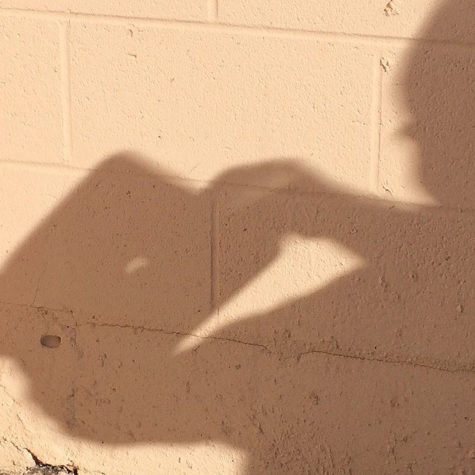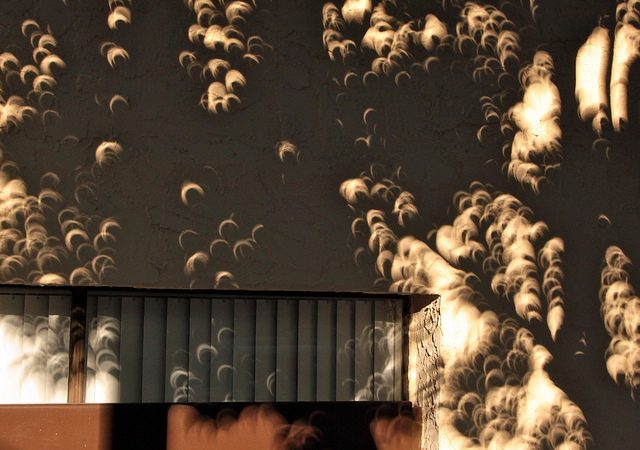So, LWON is eclipsing, on into next week. And if the internet is to be believed, half the country will be pulled north and the other half south and they’ll converge in the middle, on the path of totality. It’s charming, how a population that normally lives at arm’s length from earthly reality — milk in cartons, bears in zoos — is moved to get up close to this few minutes of celestial reality. I’m moved too, but I’m not in the path and I’m not going anywhere. And I’m not even going to look up, I’m going to look down. Because last time I saw a partial eclipse, I had an epiphany.
A sub-section of the internet tells people like me how to watch the eclipse without frying retinas, hopefully by buying its special glasses with which to look at the disappearing sun. And a sub-section of that sub-section says not to look up at the sky at all, but at the ground on which you’ve placed a piece of paper, and over that paper you hold a piece of cardboard in which you’ve made a tiny hole, a pinhole. Look at the paper on the ground and you’ll see a tiny image of the eclipse.
This is just optics. And the best way I know to describe the pinhole phenomenon is not with words but  with this silly picture that’s usually shown not as a mouse but as a candle with a flame. The light rays from the top of the flame end up at the bottom of the image, and vice versa. I’m writing about this as though I understand it but I don’t. Because other illustrations of what light does when it hits a pinhole show, not straight ray-lines, but a wavefront that curls around the back edges of the pinhole and spreads out, like ocean waves through a break in a breakwater. Worse yet, my experience of light is neither rays nor waves but more like a medium in which I live, like air. Never mind, doesn’t matter: that silly pinhole-ray reverse-image thing works.
with this silly picture that’s usually shown not as a mouse but as a candle with a flame. The light rays from the top of the flame end up at the bottom of the image, and vice versa. I’m writing about this as though I understand it but I don’t. Because other illustrations of what light does when it hits a pinhole show, not straight ray-lines, but a wavefront that curls around the back edges of the pinhole and spreads out, like ocean waves through a break in a breakwater. Worse yet, my experience of light is neither rays nor waves but more like a medium in which I live, like air. Never mind, doesn’t matter: that silly pinhole-ray reverse-image thing works.
 Anyway. During last partial eclipse in Baltimore, maybe May 10, 1994, I went out on the porch of my office building with my paper and my pinholed cardboard. I held it all just so and sure enough, there it was, a small bright crescent sun with a bite taken out of it by the moon. I was so pleased with myself, I went to show the other people from the building who’d come out with their eclipse glasses. They were not especially impressed, hardly interested. But then one of them pointed to the white floor of the porch and said, “Look.” The porch had no roof but was covered with vines, and the vines and leaves acted like pinholes. And there on the floor were a hundred tiny eclipses. I almost fainted with joy.
Anyway. During last partial eclipse in Baltimore, maybe May 10, 1994, I went out on the porch of my office building with my paper and my pinholed cardboard. I held it all just so and sure enough, there it was, a small bright crescent sun with a bite taken out of it by the moon. I was so pleased with myself, I went to show the other people from the building who’d come out with their eclipse glasses. They were not especially impressed, hardly interested. But then one of them pointed to the white floor of the porch and said, “Look.” The porch had no roof but was covered with vines, and the vines and leaves acted like pinholes. And there on the floor were a hundred tiny eclipses. I almost fainted with joy.

How had I not known this? I was 50 years old, how had I missed it? Does everyone else already know it? There it was, free, gratis, and for nothing. I didn’t have to do a thing for it, God and physics just handed it to us. People have been seeing this since Aristotle and surely way before. You can get the same effect, as Aristotle pointed out, through a wicker basket or by interleaving your fingers.
It wasn’t a big epiphany, more like goofy delight — wheee! hi there sun, hi moon! you’re so perfect! physics works! You want to pick up all those baby eclipses and give them a kiss.
______
mouse image – Oivashchenko via Wikimedia Commons; cardboard pinhole eclipse projected on wall – Leigh_A Murrell, via Flickr; leaf eclipses – torbakhopper via Flickr
I saw those tiny eclipses last time too. Had never heard of them, but was equally enchanted. They appeared in the shadow of a tree. Look forward to seeing them again.
This is really awesome! That is probably what I will do for the eclipse.
I love this and this is what I’m now doing.
How about that! And to think that on July 20, 1963, we placed boxes over our heads (called “sun scopes”) to accomplish what was waiting there for us all the time, no effort required. As the philosopher, Chico Marx, would have said, “Whatcha gonna do, huh?”